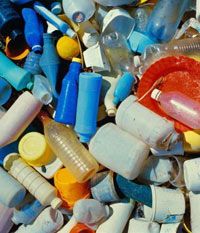Making Plastics
To make plastics, chemists and chemical engineers must do the following on an industrial scale:
- Prepare raw materials and monomers
- Carry out polymerization reactions
- Process the polymers into final polymer resins
- Produce finished products
First, they must start with various raw materials that make up the monomers. Ethylene and propylene, for example, come from crude oil, which contains the hydrocarbons that make up the monomers. The hydrocarbon raw materials are obtained from the "cracking process" used in refining oil and natural gas (see How Oil Refining Works). Once various hydrocarbons are obtained from cracking, they are chemically processed to make hydrocarbon monomers and other carbon monomers (like styrene, vinyl chloride, acrylonitrile) used in plastics.
Advertisement
Next, the monomers carry out polymerization reactions in large polymerization plants. The reactions produce polymer resins, which are collected and further processed. Processing can include the addition of plasticizers, dyes and flame-retardant chemicals. The final polymer resins are usually in the forms of pellets or beads.
Finally, the polymer resins are processed into final plastic products. Generally, they are heated, molded and allowed to cool. There are several processes involved in this stage, depending upon the type of product.
Extrusion: Pellets are heated and mechanically mixed in a long chamber, forced through a small opening and cooled with air or water. This method is used to make plastic films.
Injection molding: The resin pellets are heated and mechanically mixed in a chamber and then forced under high pressure into a cooled mold. This process is used for containers like butter and yogurt tubs. (Custompart.net has a great lesson on injection molding.)
Blow molding: This technique is used in conjunction with extrusion or injection molding. The resin pellets are heated and compressed into a liquid tube, like toothpaste. The resin goes into the chilled mold, and compressed air gets blown into the resin tube. The air expands the resin against the walls of the mold. This process is used to make plastic bottles.
Rotational molding: The resin pellets are heated and cooled in a mold that can be rotated in three dimensions. The rotation evenly distributes the plastic along the walls of the mold. This technique is used to make large, hollow plastic items (toys, furniture, sporting equipment, septic tanks, garbage cans and kayaks).
On the next page we'll learn about new innovations in plastics and how they're recycled.
